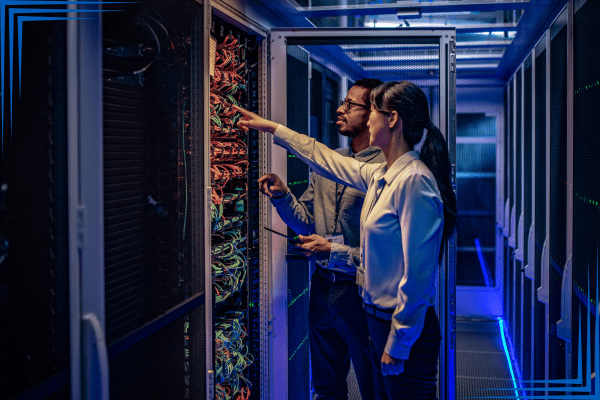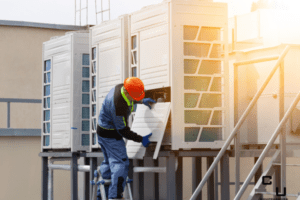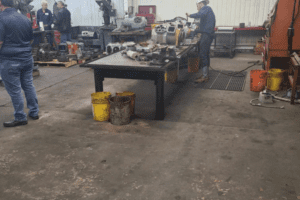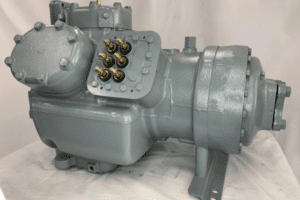Maintaining a consistent temperature in server rooms is not an easy task for commercial HVAC technicians. Servers generate significant heat, and without proper temperature control, they can overheat, causing equipment failure and data loss. The American Society of Heating, Refrigeration, and Air-Conditioning Engineers (ASHRAE) recommends server rooms maintain temperatures between 64.4°F and 80.6°F, with a relative humidity of 20-80%. Air conditioning systems must be precisely designed to manage this heat, ensuring stable airflow and preventing hot spots, which can lead to equipment malfunction or shutdowns.
Server rooms have become the backbone of modern infrastructure, supporting data-driven operations for businesses across industries. Their function is critical, and so is the need to keep these environments cool and stable. Air conditioning systems play a crucial role in this, ensuring servers operate within a safe temperature range.
The Role of HVAC in Server Room Stability
As a commercial HVAC technician, it’s important to recognize that server rooms require more than typical cooling systems. Servers operate constantly, and as they do, they emit significant amounts of heat. Unlike standard office spaces, which cool down after regular business hours, server rooms run 24/7. Even short spikes in temperature can cause irreversible damage to hardware.
When designing HVAC systems for server rooms, several key factors should be considered:
- Efficient Airflow Management: In server rooms, managing the heat generated by equipment involves more than just reducing temperature. Proper airflow across server racks is essential to dissipating heat effectively. Positioning air conditioning units and managing hot and cold air paths can significantly reduce risks of overheating.
- Temperature Range Considerations: The ASHRAE recommended range for server room temperatures is 64.4°F to 80.6°F. However, many IT professionals aim for an even narrower band of 65°F to 75°F to add an extra level of security. This minimizes the chance of temperature fluctuations that could lead to equipment failure.
- Controlling Humidity Levels: Maintaining appropriate humidity levels (between 20-80%) is just as important as temperature control. High humidity can lead to condensation, which poses a threat to electrical equipment, while low humidity increases the risk of electrostatic discharge, which can damage sensitive components.
- Reducing Temperature Spikes: Fluctuations in temperature not only shorten the lifespan of server hardware but also increase the risk of sudden outages. The failure of major systems like Hotmail in 2013 due to temperature issues underscores the critical nature of server room cooling. Constant, reliable temperature control should be a non-negotiable aspect of server room design.
Types of Cooling Systems for Server Rooms
As technology evolves, HVAC solutions for server rooms continue to advance. Depending on the specific size and needs of the server room, different types of cooling systems may be employed:
- Precision Air Conditioning Units (PACs): These units are designed specifically for server rooms, offering precise temperature control and dehumidification. They maintain consistent temperatures and are designed to operate continuously, providing cooling even in the event of increased load or external temperature shifts.
- Rack Cooling Solutions: In high-density server environments, traditional air conditioning systems may not be sufficient. Rack-based cooling systems, which provide cool air directly to each server rack, offer a more targeted solution. This system minimizes hot spots, reduces energy consumption, and increases overall efficiency.
- Water-Cooled Systems: Some large data centers opt for water-cooled systems. While more complex to install, these systems are highly efficient, using chilled water to absorb and remove heat from the server room.
As a technician, ensuring proper installation and maintenance of these systems is critical to long-term server reliability.
Why Preventive Maintenance is Essential
Even the best-designed HVAC system can fall victim to wear and tear without regular maintenance. Dust buildup, malfunctioning fans, and refrigerant leaks can all reduce the system’s ability to keep temperatures stable. Technicians should implement a comprehensive preventive maintenance plan, including regular filter changes, system inspections, compressor maintenance and performance testing.
Temperature control is more than just a comfort concern in server rooms—it’s a critical part of ensuring business continuity. Failure to maintain optimal conditions can result in costly downtime, hardware damage, and the loss of valuable data. By staying on top of maintenance, using appropriate cooling strategies, and ensuring that systems are optimized for the specific demands of server rooms, commercial HVAC/R technicians play an essential role in keeping modern infrastructure running smoothly.
Maintaining a consistent temperature in server rooms is not an option—it’s a requirement for any operation that relies on servers for data management and daily operations. HVAC/R technicians must understand the unique challenges of cooling server rooms and implement tailored solutions that address both temperature and humidity. By doing so, they ensure the integrity of critical data systems, prevent costly outages, and contribute to the efficiency and safety of these high-stakes environments.












